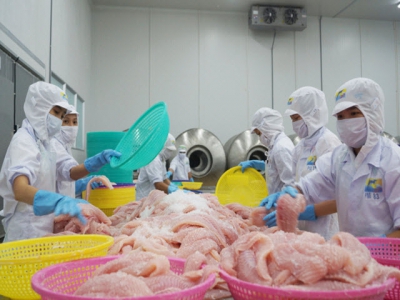Mexico is the biggest market in Latin America of Vietnams tra fish

Processing and exporting enterprises of tra fish have switched to other potential markets in ASEAN, Middle East and Latin America. In which, Mexico is one of the most remarkable markets.
Frozen fillet tra fish is one of two main products exporting to Mexico.
Facing many great difficulties in China market, Vietnam’s tra fish promptly switch to other potential markets, particularly Mexico. This is the biggest market in Latin America.
Over the years, China has been one of the most important markets of Vietnam’s tra fish. In some year, China even is the biggest market.
But when the Covid-19 pandemic occurs, since last year, exports of tra fish to China has begun fluctuating and facing many difficulties as this country increased controlling imported frozen products to prevent disease intrusion.
Dealing with the situation, processing and exporting enterprises of tra fish have switched to other potential markets in ASEAN, Middle East and Latin America. In which, Mexico is one of the most remarkable markets.
According to the statistics of the Vietnam Association of Seafood Exporters and Producers (VASEP), from January to the first half of August 2021, the total value of tra fish export to Mexico reaches US$ 43.76 million, up to nearly 70% compared to the same period last year. The export result help Mexico overtaking the No1 place of Brazil and becoming the largest export market in Latin America of Vietnam’s tra fish.
Specially, in the second quarter of 2021, the export value of tra fish to Mexico grew impressively with the speed of three digits, fluctuated in the range of 166 - 232% a month compared to the same period of 2020.
Mexico is the market with the second highest per capita income in Latin America (after Brazil). It has a free trade system with relatively low import taxes, ranging from 0 - 35% on average. This is also a market in the Comprehensive and Progressive Agreement for Trans-Pacific Partnership (CPTPP) bloc. According to the CPTPP Agreement, the import tax rate for seafood into the Mexico market will be 0% from the third year. Tra fish is the seafood product imported by Mexico with the largest volume and value, followed by tuna.
Nguyen Ha, an expert in the tuna market of the Vietnam Association of Seafood Exports and Processing (VASEP) said that after the continuous plunge in the first three months this year, Vietnam’s tuna export to Mexico has climbed up relentlessly in the two following months. In May, tuna export value to the market hit US$ 1.1 million, up 294% year on year, elevating the value of the total five months to Mexico to USD 4.8 million, up 3.8% interannually.
Mexico is one of the member markets in the CPTPP, in which Vietnam's frozen tuna meat/fillet products will be taxed under a 3-year roadmap, from the base tax rate of 20% to 0%.
According to the General Department of Customs, Vietnam is exporting the sole products of frozen tuna meat/fillet to Mexico. Over the past years, for Vietnamese imported products, Mexico had levied a high tax rate of 15% while that from Malta was 0%, Ecuador 9%, and European countries 0%. Therefore, Vietnamese frozen tuna meat/fillet found its struggle to compete with those from Malta and Ecuador. However, under the CPTPP commitments, Vietnamese frozen tuna meat/fillet products imported to Mexico enjoy 0% tax, drawing more attention from Mexican importers.
By the end of July 2021, there are more than 40 Vietnamese seafood enterprises exporting tra fish to Mexico. In which, the largest are IDI CORP, NAVICO and DATHACO. Processing enterprises of tra fish in provinces of Dong Thap, An Giang, Ben Tre, Vinh Long and Can Tho city are promoting exports to this market.
Currently, Vietnam is exporting two main tra fish products to Mexico, including frozen fillet tra fish and frozen cut cube tra fish.
According to the Ministry of Health of Mexico, in the first half of this year, about a quarter of the country's population was infected with Covid-19 and had the fourth highest death rate of the disease. However, after initial confusion and passivity, Mexico accelerated vaccination in tandem with disease control measures in many major cities. Like many other economies, at the end of August 2021, after more than 18 months of closure due to the Covid-19 pandemic, Mexico cautiously opened its economy and was ready to "live with Covid-19".
Currently, Mexican importers have begun to stabilize production and gradually increase the supply to many big cities such as Mexico, Guadalajara, Nezahualcoyotl, Monterrey, etc. The country is also maintaining the open border policy to take advantage of economic benefits, promote production and trade.
VASEP states that, the most necessary thing for tra fish exporting enterprises in Vietnam is to stabilize production after the social distancing. Since the end of July 2021, about 50% of tra fish processing factories in Mekong delta had to closed to prevent Covid-19. Those factories either could not perform “3 on-site” regulation or had cases of Covid-19 infection. In the first half of August compared to the same period last year, the three digits growth of export value of tra fish to Mexico reduced by 12.6%.
Related news
 Great opportunity for shutchi catfish exports
Great opportunity for shutchi catfish exports Under difficult conditions, shutchi catfish exports to the Mexican market grew impressively with three-digit numbers, becoming the leading export market
 Proactive prevention against epidemic diseases in lobsters farming
Proactive prevention against epidemic diseases in lobsters farming In recent years, epidemic diseases on lobster raised in Khanh Hoa Province have tended to decrease due to the preventive measures taken proactively by farmers.
 Speeding up shrimp exports to the EU
Speeding up shrimp exports to the EU It is forecast that thanks to the effectiveness of the EVFTA, the European markets will have high demand for importing shrimp at year-end